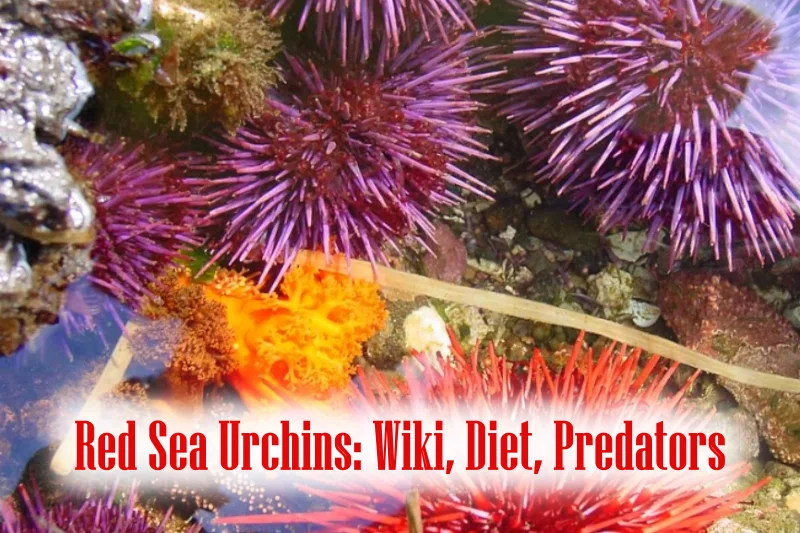Sea urchins are among the few sea creatures still harvested by hand today, and they’ve earned a spot among the most expensive seafood. In Japan, they’re affectionately known as “uni” and are prized for their umami flavor, thanks to their sugar, salt, and amino acid content. If you’re an adventurous deep-sea explorer, you’ve come to the right place.
Beneath the blue waves lies a world filled with mesmerizing creatures, and one of them is the red sea urchin. Are these spiky creatures poisonous? Now that sea urchins grace people’s plates, we can confidently say they’re safe and, most importantly, a delightful treat, especially with a squeeze of lemon.
But that’s not it, we have for you seven creatures that share the underwater world with our red sea urchin. Among these seven friends, you’ll meet the fiery Astropyga radiata and the gentle Gracilechinus acutus, all of whom play crucial roles in maintaining the ecological balance beneath the ocean’s surface.
So, without further ado, let’s dive into the marvelous world of these fascinating spiky creatures.
Red Sea Urchins (Mesocentrotus franciscanus): Wiki
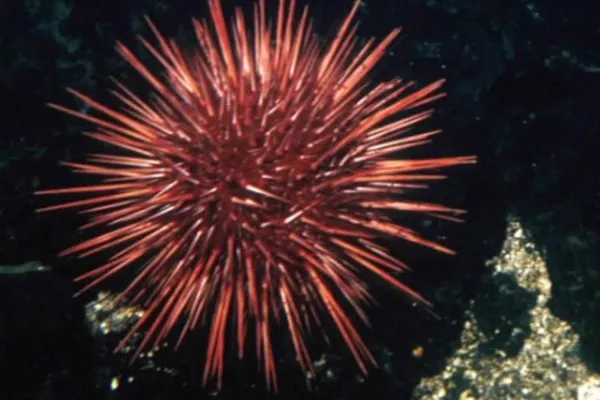
| Scientific Name | Mesocentrotus franciscanus |
| Common Name | Red Sea Urchin |
| Size | 18 cm |
| Habitat | Shallow waters from low-tide range |
| Location | Northeastern Pacific Ocean |
| Diet | Seaweeds and algae |
| Predators | Spiny lobster, California sheepshead, and sea otter |
| Colors | Dark red to black body |
| Weight | ~ 454 gm |
| Life Span | 30-200 years |
| Price | $ 40.91 (3,401.39 INR) / 1 kg |
| About it | A spherical body with sharp spines on a shell called a ‘test’, which protects the animal |
Appearance:
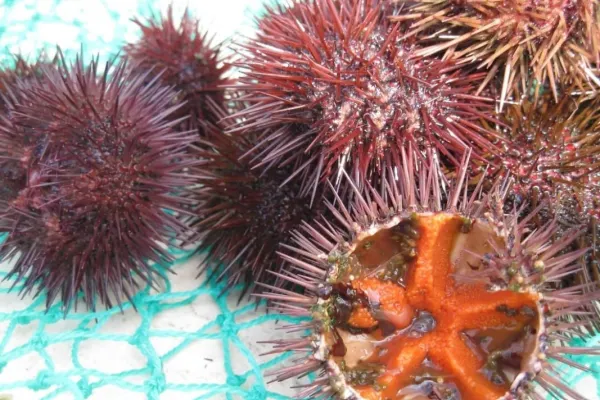
The red sea urchin showcases a striking appearance with its spherical body covered in sharp spines.
These spines grow on a ‘test’ shell enclosing the animal.
The spines are complemented by tiny tube feet equipped with suckers, aiding in movement and attachment to the sea floor.
Its coloration can vary from vibrant red to deep burgundy, sometimes featuring rare albino specimens.
Its mouth is on its underside, surrounded by five teeth used to ingest prey.
As it matures from larva to adult, the red sea urchin undergoes an interesting transition from bilateral to radial symmetry.
Geo-Location:
The red sea urchin is predominantly found along the eastern Pacific coast, ranging from Alaska to Baja California, Mexico.
It is found in a variety of shallow water habitats, from the low-tide line to depths exceeding 280 meters (920 feet).
They are commonly found in rocky coastal areas sheltered from strong wave action, usually where kelp is abundant.
They tend to avoid sand and muddy sediments.
Diet:
Red sea urchins primarily feed on seaweeds and algae by scraping them off and tearing them from the sea floor.
During their larval stage, they use their bands of cilia (small finger-like projections on the surface) to capture food from the water column.
Sometimes they take the easy road and rely on the heavy currents to bring them food.
Predators:
Despite their intimidating appearance, they face predation from several marine creatures.
Their main predators include spiny lobsters and California sheepshead in the southern regions of San Diego, while sea otters take on this role further north.
They are also frequently preyed upon by humans, octopuses, sunflower stars, wolf eels, and some crabs and birds.
Creatures Similar to Red Sea Urchins:
1) Slate pencil urchin
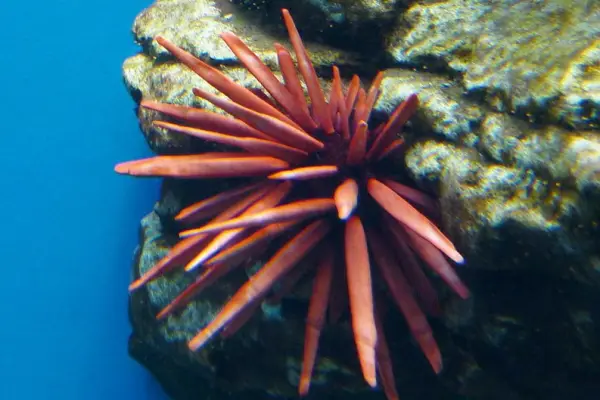
(Heterocetrotus mamillatus)
Similarities:
- Belonging to the same phylum, Echinodermata, and class, Echinoidea, they share quite a lot of similarities.
- Both red sea urchins and slate pencil urchins have spherical bodies covered in spines and are found in similar depths, typically ranging from shallow coastal waters to deeper subtidal zones.
- Both species have an herbivorous diet, primarily feeding on various algae (kelp) types.
- Both their spines act as defense mechanisms against predators, mobility aid, and help in burrowing or anchoring to substrates.
Differences:
- Red pencil slate urchins mostly inhabit the Indo-Pacific region, while red sea urchins are found in the northeastern Pacific Ocean.
- While the Slate pencil urchin primarily consumes coralline algae, the red sea urchin is known for its inclination toward seaweeds and algae (usually brown).
- While the pencil urchin can be bright red, brown, or purple, the red sea urchin displays color variations ranging from red to dark burgundy.
2) Violet sea urchin
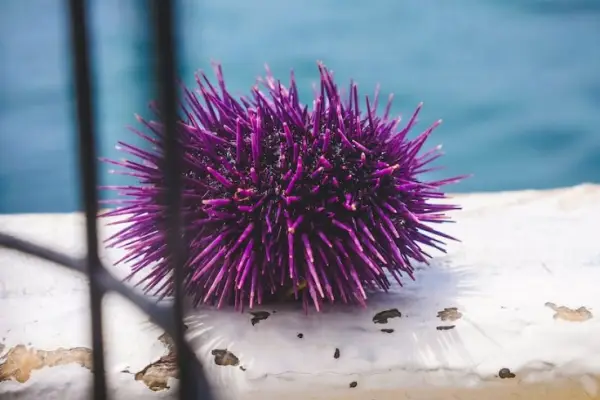
(Sphaerechinus granularis)
Similarities:
- Violet sea urchins and red sea urchins belong to the same phylum and class.
- Both violet sea urchins and red sea urchins are characterized by their spherical bodies covered in spines.
- Both species share a herbivorous diet.
- Violet sea urchins and red sea urchins have spines that are used as a defense against predators and assist in mobility.
- Another similarity between these species is that they reproduce through external fertilization, where eggs and sperm are released into the water column.
Differences:
- While the violet sea urchin feeds on algae, including encrusting coralline algae and seagrass blades, the red sea urchin is known for its preference for seaweeds and algae.
3) Reef urchin
(Echinometra viridis)
Similarities:
- The red sea urchin and reef urchin share many similarities one of them being that they belong to the same phylum and class.
- With the spiney structure on their body, both red sea urchins and reef urchins defend themselves and feed on prey.
- Both red sea urchins and reef urchins share an herbivorous diet, primarily feeding on algae.
- Both equally contribute to creating an ecological balance in the marine ecosystem.
- Red sea urchins and reef urchins reproduce through external fertilization, releasing eggs and sperm into the water column.
Differences:
- While the reef urchin feeds on fleshy algae, the red sea urchin is known for feeding on seaweeds and algae.
4) False fire urchin
(Astropyga radiata)
Similarities:
- Like the three previous species we discussed, the False Fire urchins and the Red Sea urchin share the same class and phylum.
- The false fire urchins and red sea urchins are known for their spherical bodies covered in spines and hence are classified as sea urchins.
- Another similarity they share is their reputation for being among the larger species of sea urchins.
Differences:
- False fire urchin showcases a range of colors from reddish-brown to purple, dark brown, or nearly black, along with distinctive blue dots on the spines, while the red sea urchins are mostly dark or bright red.
- False fire urchins are found in lagoons and bays with sandy, shingle, or coral rubble substrates, while the red sea urchin is typically found on rocky shores sheltered from extreme currents.
5) Green sea urchin
(Lytechinus variegatus)
Similarities:
- Both green sea urchins and red sea urchins share the same phylum and class that is Echinodermata and Echinoidea respectively.
- They have spherical bodies covered in spines that play various roles, including protection and movement.
- One of the other similarities is that they use their specialized structures called the tube feet and Aristotle’s lantern (a feeding apparatus) to graze on plant material.
Differences:
- As inhabitants of the marine world, the green sea urchins are found in the warm waters of the western Atlantic Ocean and the Caribbean Sea, while the red sea urchin is typically found in the northeastern Pacific Ocean from Alaska to Baja California.
6) White sea urchin
(Gracilechinus acutus)
Similarities:
- The Gracilechinus acutus and Mesocentrotus franciscanus belong to the same class of Echinoidea within the phylum Echinodermata.
- Both these sea urchin species have spherical bodies covered in spines that help in their protection.
- White sea urchins play the role of the bioindicator by indicating the amount of algal content present in the environment.
- This is important as the amount of algae could result in algal blooms resulting in a decrease in the oxygen content in the water bodies.
Differences:
- Even though the red sea urchin is not known for its role as a bioindicator, both the white and red sea urchins hold ecological significance.
- Another difference is that, while Gracilechinus acutus is predominantly reddish to brown-red, the red sea urchin is known for its reddish or purple coloration.
- White sea urchin is found in regions of the Atlantic Ocean, the English Channel, the North Sea, and the Mediterranean Sea, while the red sea urchin typically resides in the northeastern Pacific Ocean.
7) Long-spine slate pen sea urchin
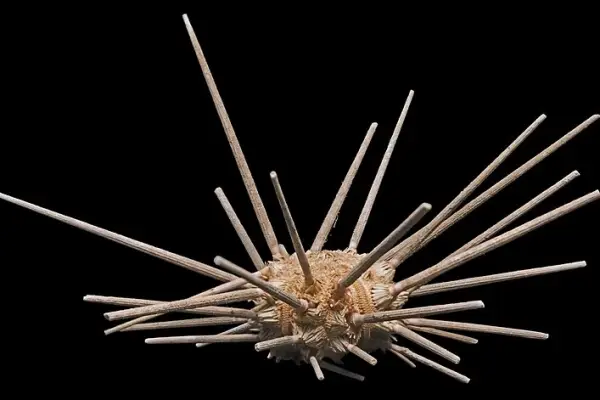
(Cidaris cidaris)
Similarities:
- Both the Long-spine slate pen sea urchin and the red sea urchin belong to the class Echinoidea and the phylum Echinodermata.
- They also play a role in controlling algal populations in their respective ecosystems, while also playing a major role in maintaining a balance in the food cycle.
Differences:
- Another difference is their location, while Cidaris cidaris inhabits deep waters in the eastern Atlantic Ocean and the Mediterranean Sea, the red sea urchin is primarily located in the northeastern Pacific Ocean.
- Long-spine slate pen sea urchins exhibit long, blunt primary spines along with secondary spines covering them.
- The red sea urchin has both primary and secondary spines, but the two emerge from the same test (protective layer that encloses the animal)
Conclusion:
As we bid adieu to our underwater buddies, let’s take care of these ocean pals and their homes and do our part to look after them. Together, we can make sure the sea stays an incredible place full of wonder for everyone to enjoy.
Red sea urchins are not only breathtakingly beautiful they, along with their friends belonging to the same family play an important role in maintaining ecological balance.
The interaction between sea otters and urchins can lead to significant ecological impacts on kelp beds along the west coast of North America.
References:
- https://www.tridge.com/intelligences/sea-urchin/price
- https://marinespecies.wildlife.ca.gov/red-sea-urchin/the-species/#:~:text=Red%20sea%20urchin%20weight%20fluctuates,))%20(CDFW%20unpublished%20data).
- https://caseagrant.ucsd.edu/seafood-profiles/red-sea-urchin
- https://en.wikipedia.org/wiki/Red_sea_urchin
- https://www.aquariumofpacific.org/onlinelearningcenter/species/red_sea_urchin
- https://en.wikipedia.org/wiki/Heterocentrotus_mamillatus
- https://en.wikipedia.org/wiki/Sphaerechinus_granularis
- https://en.wikipedia.org/wiki/Echinometra_viridis
- https://en.wikipedia.org/wiki/Astropyga_radiata
- https://en.wikipedia.org/wiki/Lytechinus_variegatus
- https://en.wikipedia.org/wiki/Cidaris_cidaris
Also Read:

Hi everyone, my name is Shawna, and I’ve always been fascinated by the fascinating diversity of flora and fauna that our nature has in it. I am currently studying biotechnology and am particularly interested in animal biotechnology, delving into the intricate processes that define their true nature and uniqueness.
